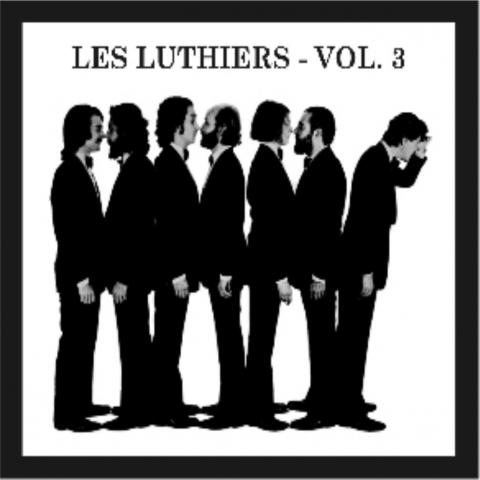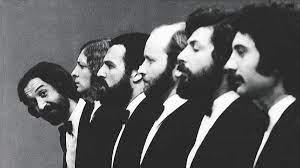
Les Luthiers está de despedida. De despedida definitiva. Sobrevivieron a la muerte de tres de sus fundadores (Gerardo Masana, 1973; Daniel Rabinovich, 2015; Marcos Mundstock, 2020) y a la jubilación de dos de sus integrantes históricos (Ernesto Acher, 1986; Carlos Núñez Cortés, 2017), pero no han podido sobrevivir al cansancio y la edad de los otros dos (Jorge Maronna y Carlos López Puccio, que ya tienen 75 y 76 años). Cuesta decirles adiós, aceptar su desaparición, pero es ley de vida. Los años pasan y los artistas envejecen o mueren.
El grupo se retira con una supergira, como no podía ser de otra forma. Una supergira que los tuvo por España, donde siempre han sido muy bien acogidos, desde el 31 de mayo (Madrid) hasta el 9 de julio (San Feliu de Guíxols, Girona). Su despedida de España lo fue también de Europa. Ahora se andan despidiendo de América: su Argentina, Chile, Uruguay, Bolivia, Costa Rica, Perú y EEUU.
La banda ha tenido la generosidad de incorporar en su último espectáculo –Más tropiezos de Mastropiero– material inédito por primera vez en 15 años. Sus funciones anteriores fueron recopilatorias.
Les Luthiers dice adiós al público después de 56 años. Casi nada. Nacieron en Buenos Aires en 1967, de las brasas de I Musicisti, en donde ya estaban Masana, Mundstock, Rabinovich y Núñez Cortés. Con este grupo ensayaron una nueva fórmula: usar la música para hacer humor. Porque todos –menos Mundstock, que era locutor y publicista– venían de la música; en concreto, de los coros universitarios, que tanto proliferaron en Argentina a mediados de los años 60. En realidad, el origen de la formación está en el VI Festival de Coros Universitarios de San Miguel de Tucumán, donde –antes de ser aún I Musicisti– sorprendieron con la parodia de un concierto de música clásica cuya obra central era la Cantanta Modatón (luego llamada Laxatón, para evitar problemas legales), de Gerardo Masana, con música inspirada en la Pasión según San Mateo, BWV 244, de Johann Sebastian Bach, y letra sacada del prospecto de un conocido laxante.
Desde su fundación, Les Luthiers ha conocido ocho formaciones. Empezaron siendo cuatro miembros (Masana, Maronna, Mundstock y Rabinovich), que pronto se convirtieron en cinco (con la incorporación de Núñez Cortés en 1969) para pasar luego a siete (con Acher y López Puccio en 1971, aunque el segundo ya colaboraba con el grupo desde 1969) y después menguar a seis (por la muerte de Masana en 1973) y finalmente a cinco (tras la salida de Acher en 1986). La formación en quinteto duró la friolera de 29 años (1986-2015), por lo que es la más conocida.
Les Luthiers tuvo la genialidad de unir música y humor, pero una música y un humor muy particulares y sublimes. En cuanto a la música, además del talento y la preparación de sus miembros, destaca la osadía de apostar por instrumentos informales (más que informales: disparatados, casi imposibles), realizados con materiales de la vida cotidiana. Esto fue lo que les dio el nombre de “luthiers”, labor que corrió a cargo primero de Masana y luego, sucesivamente, de los artesanos Carlo Iraldi, Hugo Domínguez y Fernando Tortosa. Nacieron así la violata, el chelato, la mandocleta, el barríltono, la desafinaducha, el bolarmonio y tantos otros, todos inclasificables.
Respecto al humor, además de inteligente y sutil, el de Les Luthiers es un maravilloso canto a los juegos de palabras. Yo, que soy un enamorado de las posibilidades lúdicas del lenguaje, debo confesar que, en buena medida, fue por ahí por donde me ganaron estos locos admirables. Un ejemplo más que bueno es el “Monólogo mal puntuado”, interpretado por un genial Rabinovich y al que pertenecen estas delirantes frases: “…muchas veces he citado el fracaso de su operación… el fracaso de su ópera Sión y el judío era antes… y el judío errante, que se basaba en una vieja leyendo ebria… en una vieja leyenda hebrea. ¡Me di cuenta enseguida! ¡No podía ser! ¡Ebria va con hache!”. Núñez Cortés sistematizó los juegos de palabras del grupo en un libro extraordinario titulado Los juegos de Mastropiero (2016). Por cierto que existen otros dos libros sobre la banda: Les Luthiers de la L a la S (1991), del periodista colombiano Daniel Samper, y Gerardo Masana y la fundación de Les Luthiers (2014), de Sebastián Masana, hijo del fundador del grupo.
Además, acertaron de pleno con un personaje como Johann Sebastian Mastropiero, hilo conductor de sus espectáculos ya desde 1967, cuando la banda aún actuaba como I Musicisti.
Todo esto les ha valido los más altos reconocimientos, como la declaración de Ciudadanos Ilustres de la Ciudad de Buenos Aires (2007), la Orden de Isabel la Católica (2007) que entrega el Gobierno español, un Premio Grammy Latino (2011) y el Premio Príncipe de Asturias de Comunicación y Humanidades (2017), otorgado también a otro porteño universal –el humorista gráfico Joaquín Lavado Quino– tres años antes.
Les Luthiers nacieron el mismo año que yo, por lo que me han acompañado siempre desde que los descubrí con unos diez años de edad. Fue a través de su disco Volumen 3 (1973), que recuerdo siempre en mi casa, aunque no lo debí de escuchar hasta que cumplí mi primera década de vida. Ese disco –el tercero del grupo– fue el último de Masana, que moriría ese mismo año. Tenía una portada excelente, que me llamaba mucho la atención, en la que aparecían seis de los miembros de la banda enfrentados por parejas nariz con nariz, mientras que el séptimo, solo, de espaldas al último, oteaba el horizonte. Todos vestían de traje y pajarita. Recuerdo especialmente un corte de ocho minutos titulado “Suite de los noticieros cinematográficos”, que llevaba como cabecera la frase “¿Qué sucedió en la semana, eh?” y se abría y cerraba con una breve sintonía interpretada por un kazoo, un tipo de pito de chapa o mirlitón, el mismo que usarían unos años después Javier Krahe, Joaquín Sabina y Alberto Pérez en su álbum La Mandrágora (1981). De esa “Suite” me encantó el sketch titulado “Actualidad latinoamericana”, en la que Les Luthiers parodiaban la toma de posesión de un gobierno militar en la Sudamérica de la época. El presidente –un general– tomaba juramento a sus ministros. Uno era general; otro, contralmirante; un tercero, brigadier. Todos, con nombres rimbombantes. Finalmente, como ministro de Educación y Cultura, juraba el “cabo primero Anastasio López”. También me acuerdo particularmente del sketch titulado “Desarrollo Industrial”, sobre la inauguración de las nuevas instalaciones de la envasadora de bebidas gaseosas “Algarrobo Pampeano”, en la que el párroco de la planta bendecía el lugar reemplazando, “en un simpático gesto”, el agua bendita por Algarrobo Cola, “que refresca mejor”.
Tuve ocasión de ver a Les Luthiers actuar en directo tres veces, todas en España. La primera, en 1987, en Pamplona, cuando aún estaba estudiando en la Universidad. Presentaron su espectáculo Viegésimo aniversario, con el que celebraban sus primeros 20 años. Quedé maravillado. La segunda, en Santiago de Compostela, en los años 90. No recuerdo bien qué espectáculo era. Debió de ser Les Luthiers, grandes hitos (1992); Unen canto con humor (1994) o Todo por que rías (1999), tres excelentes ejemplos, por cierto, de juegos de palabras (grandes hitos / grandesitos; unen canto / un encanto; por que rías/ porquerías). La última vez fue el año pasado, en Vigo, con Gran Reserva, donde tuve la satisfacción de llevar conmigo a mi ahijado Robel, que acababa de cumplir 16 años y desconocía por completo al grupo.
Después de 56 años siendo felices en los escenarios y haciéndonos felices a nosotros, Les Luthiers se retira. Nos quedan sus viejos discos en vinilo y CD, sus no tan viejos vídeos en DVD y sus modernos vídeos en YouTube. ¿Volveremos a verlos en escena? A los fallecidos Masana, Rabinovich y Mundstock, desde luego que no; y a los setentones Maronna y López Puccio parece que tampoco. Pero tal vez –quién sabe– los cuatro nuevos integrantes que empezaron como suplentes durante las giras (Tato Turano, Martín O’Connor, Roberto Antier y Tomás Mayer-Wolf) se animen un día a recuperar algunas de las viejas obras del grupo, siempre y cuando reciban el beneplácito de los poseedores de los derechos, los tres fundadores vivos y los herederos de Mundstock y Rabinovich.
Larga vida a Les Luthiers, dentro o fuera de los escenarios.



In the goodbye of Les Luthiers
By Félix Caballero
Les Luthiers is saying goodbye. Final farewell. They survived the death of three of their founders (Gerardo Masana, 1973; Daniel Rabinovich, 2015; Marcos Mundstock, 2020) and the retirement of two of their historical members (Ernesto Acher, 1986; Carlos Núñez Cortés, 2017), but they have not able to survive the fatigue and the age of the other two (Jorge Maronna and Carlos López Puccio, who are now 75 and 76 years old). It is hard to say goodbye to them, to accept their disappearance, but it is the law of life. Years go by and artists grow old or die.
The group leaves with a super tour, how could it be otherwise. A super tour that took them to Spain, where they have always been very well received, from May 31 (Madrid) to July 9 (San Feliu de Guíxols, Girona). His farewell to Spain was also to Europe. Now they are saying goodbye to America: their Argentina, Chile, Uruguay, Bolivia, Costa Rica, Peru and the US.
The band has had the generosity of incorporating unpublished material into their latest show –Más tropiezos de Mastropiero– for the first time in 15 years. His previous functions were compilations.
Les Luthiers says goodbye to the public after 56 years. Almost nothing. They were born in Buenos Aires in 1967, from the coals of I Musicisti, where Masana, Mundstock, Rabinovich and Núñez Cortés were already present. With this group they tested a new formula: using music to create humor. Because everyone –except Mundstock, who was a broadcaster and publicist– came from music; specifically, of the university choirs, which proliferated so much in Argentina in the mid-60s. In reality, the origin of the formation is in the VI Festival of University Choirs of San Miguel de Tucumán, where –before it was still I Musicisti – surprised with the parody of a classical music concert whose central work was Cantanta Modatón (later called Laxatón, to avoid legal problems), by Gerardo Masana, with music inspired by the Saint Matthew Passion, BWV 244, by Johann Sebastian Bach , and lyrics taken from the prospectus of a well-known laxative.
Since its foundation, Les Luthiers has known eight formations. They began with four members (Masana, Maronna, Mundstock and Rabinovich), which soon became five (with the incorporation of Núñez Cortés in 1969) and then seven (with Acher and López Puccio in 1971, although the latter was already collaborating with the group since 1969) and then dwindle to six (after Masana's death in 1973) and finally to five (after Acher's departure in 1986). The quintet formation lasted a whopping 29 years (1986-2015), which is why it is the best known.
Les Luthiers had the genius of uniting music and humor, but very particular and sublime music and humor. As for music, in addition to the talent and preparation of its members, the audacity to bet on informal instruments (more than informal: crazy, almost impossible) stands out, made with materials from everyday life. This was what gave them the name "luthiers", a task that was carried out first by Masana and then, successively, by the artisans Carlo Iraldi, Hugo Domínguez and Fernando Tortosa. This is how the violata, the chelato, the mandocleta, the barríltone, the desatunaducha, the bolarmonio and many others, all unclassifiable, were born.
Regarding humor, as well as being intelligent and subtle, that of Les Luthiers is a marvelous hymn to puns. I, who am in love with the playful possibilities of language, must confess that, to a large extent, it was there that these admirable lunatics won me over. A more than good example is the “Poorly punctuated monologue”, performed by a brilliant Rabinovich and to which these delirious phrases belong: “…many times I have cited the failure of his operation… the failure of his opera Zion and the Jew was before… and the Wandering Jew, which was based on an old woman reading drunk… on an old Hebrew legend. I noticed right away! It couldn't be! Drunk goes with hache!" Núñez Cortés systematized the group's puns in an extraordinary book entitled Los juegos de Mastropiero (2016). By the way, there are two other books about the band: Les Luthiers de la L a la S (1991), by Colombian journalist Daniel Samper, and Gerardo Masana and the Foundation of Les Luthiers (2014), by Sebastián Masana, son of the founder of the cluster.
In addition, they were absolutely right with a character like Johann Sebastian Mastropiero, the guiding thread of their shows since 1967, when the band was still performing as I Musicisti.
All this has earned them the highest recognitions, such as the declaration of Illustrious Citizens of the City of Buenos Aires (2007), the Order of Isabel la Católica (2007) awarded by the Spanish Government, a Latin Grammy Award (2011) and the Prince of Asturias Award for Communication and Humanities (2017), also awarded to another universal porteño –the cartoonist Joaquín Lavado Quino– three years earlier.
Les Luthiers were born the same year as me, so they have always been with me since I discovered them when I was about ten years old. It was through his album Volume 3 (1973), which I always remember at home, although I must not have listened to it until I was my first decade of life. That record –the group's third– was the last by Masana, who would die that same year. It had an excellent cover, which caught my attention, in which six of the band members appeared facing each other nose to nose, while the seventh, alone, with his back to the last one, was scanning the horizon. They all wore suits and bow ties. I especially remember an eight-minute cut titled “Movie News Suite”, which had as its header the phrase “What happened in the week, huh?” and it opened and closed with a brief tune played by a kazoo, a type of sheet metal whistle or kazoo, the same one that Javier Krahe, Joaquín Sabina and Alberto Pérez would use a few years later on their album La Mandrágora (1981). From that "Suite" I loved the sketch entitled "Latin American News", in which Les Luthiers parodied the inauguration of a military government in South America at the time. The president –a general– swore in his ministers. One was a general; another, rear admiral; a third, brigadier. All, with bombastic names. Finally, as Minister of Education and Culture, "First Corporal Anastasio López" was sworn in. I also particularly remember the sketch entitled “Industrial Development”, about the inauguration of the new facilities of the “Algarrobo Pampeano” soft drink packaging company, in which the parish priest of the plant blessed the place, replacing, “in a nice gesture”, the holy water for Algarrobo Cola, “which refreshes better”.
I had the chance to see Les Luthiers perform live three times, all in Spain. The first, in 1987, in Pamplona, when he was still studying at the University. They presented their 20th anniversary show, with which they celebrated their first 20 years. I was amazed. The second, in Santiago de Compostela, in the 90s. I don't remember exactly what show it was. It must have been Les Luthiers, great milestones (1992); They unite singing with humor (1994) or Todo porque que rías (1999), three excellent examples, by the way, of puns (great milestones / grandesitos; they unite singing / a charm; why you laugh / crap). The last time was last year, in Vigo, with Gran Reserva, where I had the satisfaction of taking my godson Robel with me, who had just turned 16 and was completely unaware of the group.
After 56 years of being happy on stage and making us happy, Les Luthiers retires. We are left with his old vinyl records and CDs, his not-so-old DVD videos and his modern YouTube videos. Will we see them on stage again? To the late Masana, Rabinovich and Mundstock, certainly not; and the seventies Maronna and López Puccio seem not to either. But perhaps – who knows – the four new members who began as substitutes during the tours (Tato Turano, Martín O'Connor, Roberto Antier and Tomás Mayer-Wolf) will one day be encouraged to recover some of the group's old works, always and when they receive the approval of the rights holders, the three living founders and the heirs of Mundstock and Rabinovich.
Long live Les Luthiers, on or off stage.
(This text has been translated into English by Google Translate)
